
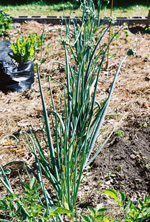
I've got some from my 97 year old neighbor - she tells me that her Pfeifer grand-parents grew these same onions starting around 1850 in Fort Atkinson, WI - she's still using the same seed saved year after year for over 150 years.
The special feature of this onion variety is the growth of seed on top of the leaves (top setting bulbs). The plant keeps growing larger top-setting-seed and the flow of juices keep the leaves green much longer than other varieties of onions. It propagates by letting the top seed fall on the soil, thus little energy is put into developping a large bulb in the ground.
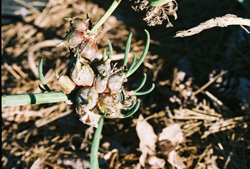
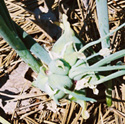
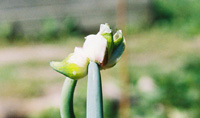
The seed is very hardy ... you can drop it on the soil even in very late fall before the first snow fall. Keep some in your garden shed all winter and plant them in the spring and through the summer, so you have a supply of green onions for most of the year.
Or leave a few onions in the ground and let them walk!
NOT REALLY! You don't want to let the plant do that. In the picture above you see a clump of seed grown on top of a leaf that gravitation took down to the soil. You can count about 8 - 10 seeds in this clump. You don't want 10 onions to grow in the same spot. Therefore it is better to harvest the seed. Let it dry out a little and separate.
Space the seed about 2 inches apart in a row.
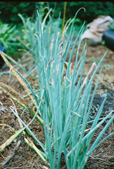
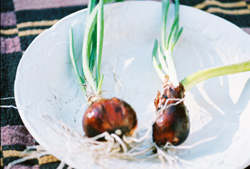
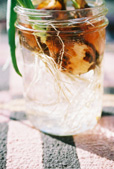
Notice on the picture above in the middle: the bulb on the right side in the dish has small green growth coming out of the top and large stem to the right. The large stem to the right is the old growth that had the top-set bulbs; it is too hard to eat.
The new growth is delicious, especially in September when nobody has fresh green onions. By keeping the harvested bulbs in water, I preserve the quality of the roots until ready to cook. So, I remove the skin and the hard stem, but eat the white bulb, the fresh greens and the roots. Go find onion roots in my breakfast garbage plate.
I'm impressed by the size of the top-setting bulbils - a few grew to almost 2" across (see picture below - the square pattern is half an inch) - and the second growth "by stooling" gives me a second harvest of greens. I'm planning to leave a few bulbs of this row through the summer to see if I get a second harvest of top-setting bulbils (to compare the size with the first year growth).
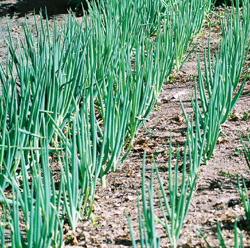
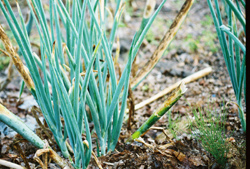
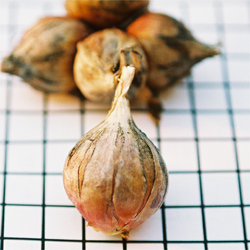
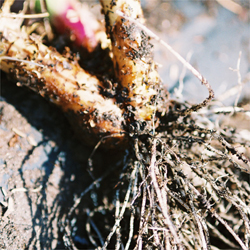
In the top picture you can observe how the green bulbs (3) are bunching with a common root base.
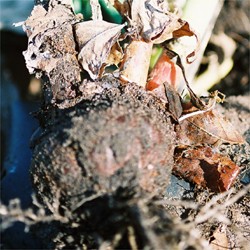
When you harvest you will find a little more cleaning of rotten bulb residue. Each bulb may have up to 12 onion greens growing from the common root base.
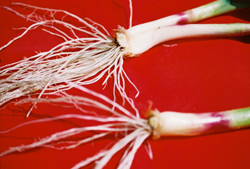
The green growth of the seed bulb is larger in size, while out of the summer bulb I've harvested more greens.
Once you are satisfied with the quality of your plants and keep saving seeds for several years, the time comes to start sharing seeds.
Become a member of Seed Savers Exchange. www.seedsavers.org/membership
By becoming a member ($35 per year membership fee) you can order seed from 700 plus sources. Unfortunately there are only 35 seed savers in Wisconsin and 33 in Illinois ... but none in Kenosha and Racine Counties.
We need to change that and have more local gardeners listed in Seed Savers Year Books to make seed available to other local gardeners.
This page lists all cultivars that I save - some are available to all (HAS), most are reserved to "listed" SSE members - click here to review the list of cultivars.
Please call Seed Savers, become a "non-listed" member (support this no-profit organization) and eventually join me in offering seed as a listed member. Call (563) 382-5990
Forward this link; it will take them to the free subscription page.
http://www.curzio.com/N/subscribe.htm
If you need help subscribing please drop us a note; we can do that for you.
We hope you enjoy receiving our newsletter and will forward it to your friends and family. We appreciate your help in spreading the word about our activity.
Looking forward to meet you at the Kenosha HarborMarket this Saturday, or some day.
Your friend will be under the white tent,
Curzio